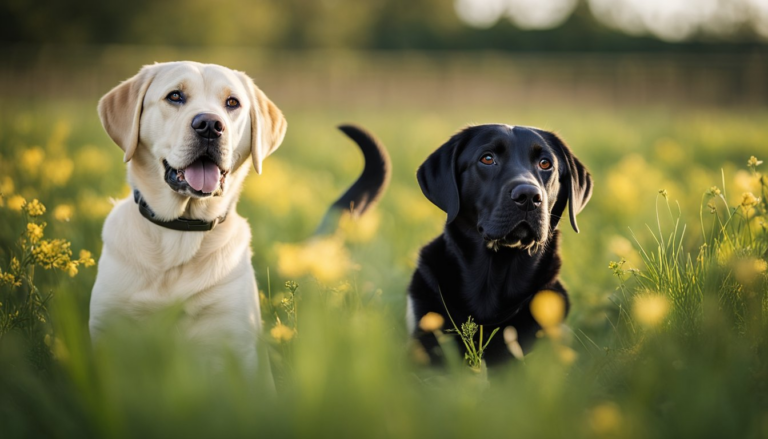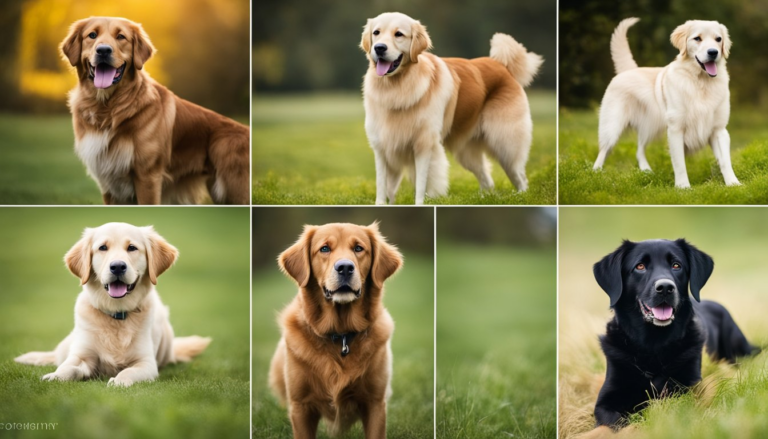Flat-Coated Retriever Breed Guide: Essential Insights and Details
The Flat-Coated Retriever is a versatile and energetic breed that has captured the hearts of many dog enthusiasts. Known for their intelligence, playfulness, and cheerful nature, these dogs are ideally suited for active families who are looking for a loyal and entertaining companion.
Originating in the mid-19th century, the Flat-Coated Retriever was primarily bred for its talent in retrieving game during hunts. Today, this breed is recognized by organizations such as the American Kennel Club and the Flat-Coated Retriever Society of America for its outstanding qualities as a family pet and working dog.
One of the key aspects that sets the Flat-Coated Retriever apart from other retriever breeds is its distinctive appearance. This breed sports a sleek, solid-colored coat that ranges from black to liver in color, giving it a charming and elegant look.
Beyond their physical appeal, Flat-Coated Retrievers are admired for their friendly and social personality. As adaptable and good-natured dogs, they thrive in various living conditions, making them an excellent choice for those seeking a family dog that can adapt to different environments.
Key Takeaways
- Flat-Coated Retrievers are versatile, intelligent, and cheerful dogs, making them great family pets and working dogs
- This breed is admired for its distinctive appearance and friendly disposition, suitable for different living conditions
- Bred originally for game retrieval, the Flat-Coated Retriever is now recognized by prominent organizations like the American Kennel Club and the Flat-Coated Retriever Society of America
Breed History and Origin
Development and Origins
The Flat-Coated Retriever is a breed that originated in England during the 19th century. This breed of dog was developed by crossing various working breeds such as Newfoundland, Labrador, and Setter types with water spaniels, and its development can be better understood when considering the broader research on canine population structure.
These crossings resulted in a dog with excellent hunting and retrieving abilities, as well as an appealing appearance. The breed became popular in England during the latter part of the 19th century, where it was used mainly for hunting and retrieving purposes.
One of the early enthusiasts and advocates for the Flat-Coated Retriever was Mr. J. Hull, who bred and showed the dogs under the famous “Riverside” kennel name. His dog, Peter Pan, won numerous awards and was considered a prime example of the breed. Through Mr. Hull’s efforts, the breed gained recognition and became highly regarded by hunters and dog enthusiasts alike.
Original Purpose
The original purpose of the Flat-Coated Retriever was to serve as a versatile gundog that could adeptly work in the field, retrieving both upland game birds and waterfowl. With their keen sense of smell and strong swimming abilities, these dogs were particularly valuable on hunts conducted in marshy regions and around bodies of water.
Their gentle mouth and ability to carefully retrieve hunted game without causing any damage made them a favorite among hunters, and their exceptional performance in the field eventually led to the breed’s participation in field trials. These trials showcased the Flat-Coated Retriever’s abilities to locate and retrieve game efficiently, further solidifying their status as an accomplished gundog.
Gradually, Flat-Coated Retrievers gained recognition not only for their working abilities, but also for their good temperament and sociable nature. This made the breed well-suited as a family companion and contributed to its present-day popularity as both a working and companion dog.
Physical Characteristics
Size
| Characteristic | Male | Female |
| Height | 23 to 24.5 inches | 22 to 23.5 inches |
| Weight | 60 to 70 pounds | 55 to 65 pounds |
| Coat Color | Black or Liver | Black or Liver |
Coat
Flat-Coated Retrievers are known for their distinctive, glossy coat. The coat is of medium length and lies flat against the body, giving the breed its name. Their fur is dense, providing excellent protection from harsh weather conditions.
Grooming Needs and Frequency: To maintain the coat’s sleek appearance, regular grooming is necessary. It’s recommended to brush the coat at least once a week to remove loose hair and prevent matting. Bathing should be done as needed to keep the coat clean and healthy.
Lifespan
The average life expectancy of a Flat-Coated Retriever is around 10 to 12 years. This lifespan can vary depending on factors such as genetics, diet, and overall health. Regular veterinary check-ups and a balanced diet can help ensure they live a healthy and happy life.
Distinctive Features

The Flat-Coated Retriever boasts several distinctive features that set it apart from other types of retriever. One of the most noticeable features is their long, well-defined muzzle, which gives them a noble appearance. Their shiny coat is another eye-catching feature that adds to their unique look.
The head of a Flat-Coated Retriever is broad and flat, with a gentle transition between the forehead and the muzzle. The body is well-proportioned, with a deep chest and a strong, muscular build. Their tails are of medium length and carried straight or slightly raised, adding to their athletic and energetic appearance.
Overall, the Flat-Coated Retriever is an elegant and functional breed, well-suited for its original purpose as a gundog.
Temperament and Personality
General Disposition
Flat-Coated Retrievers are known for their happy, social, and intelligent personalities. They are generally friendly, good-natured dogs who love to be around people, including children. Their cheerful and playful nature makes them great family pets. They are also energetic and adaptable, making them suitable for various types of households and living situations.
Behavior
These dogs are characterized by their exuberance, friendliness, and optimism. They typically get along well with other pets and are welcoming to strangers, which makes them poor guard dogs but excellent companions.
Flat-Coated Retrievers are active dogs who enjoy participating in outdoor activities with their owners, such as swimming or playing fetch. Due to their high energy levels, it is highly recommended to provide them with regular exercise and mental stimulation to prevent boredom and destructive behavior.
Trainability

Flat-Coated Retrievers are known for their trainability, as they are eager to please and respond well to positive reinforcement. Their intelligence and adaptability make them suitable for various types of training, including obedience, agility, and even service or therapy work.
When training a Flat-Coated Retriever, it is highly advisable to use consistent, clear commands and provide plenty of praise and rewards for good behavior. Due to their energetic and playful nature, incorporating fun and engaging activities into their training sessions can help improve their focus and enhance their learning experience.
Health and Wellness
Common Health Issues
Flat-Coated Retrievers are generally healthy dogs, but they can be prone to certain health issues. Some of the most common problems include hip dysplasia, bloat, and certain types of cancer, such as histiocytic sarcoma, as detailed in the study of histopathologic classification of histiocytic sarcomas in Flat-Coated Retrievers. Additionally, some Flat-Coated Retrievers may develop cataracts and other eye-related issues.
Health Screenings

To maintain the health and wellness of Flat-Coated Retrievers, regular check-ups with a veterinarian are essential. Preventative screenings for hip dysplasia, eye examinations, and regular blood tests for various cancers are recommended, as they can help identify potential issues early. Owners and breeders should also monitor this breed for any signs of bloat, a life-threatening condition that requires immediate medical attention.
Diet and Nutrition
A well-balanced diet is necessary for the overall health of Flat-Coated Retrievers. High-quality dog food, either commercially prepared or home-prepared under veterinary guidance, should be provided to meet their nutritional needs.
Owners should keep an eye on their dog’s weight, as overeating could lead to obesity and related health complications. Flat-Coated Retrievers are also prone to bloat, so it’s necessary to divide their meals into smaller portions, avoid feeding them immediately before or after vigorous exercise, and discourage rapid eating.
Exercise Needs
Flat-Coated Retrievers are energetic dogs that require regular physical activities to stay healthy and happy. Ideally, they should have at least an hour of daily exercise, which may include activities like hiking, swimming, or long walks.
This breed also has a high activity level and may become bored or destructive if not provided with sufficient mental stimulation, so incorporating games and training exercises into their routine can be beneficial. Regular exercise is needed for maintaining their physical health and mental well-being, particularly in preventing obesity and keeping the dog’s energy levels stable.
Training and Behavior
Early Socialization

Flat-Coated Retrievers are intelligent, energetic, and social dogs. Early socialization is highly recommended for this breed to develop good habits and behaviors. Start socializing your puppy as early as possible, introducing them to various environments, people, and other animals.
This helps them build confidence and ensures that they will grow up to be well-behaved, friendly dogs. Puppy training classes are an excellent way to socialize your pup and give them an opportunity to interact with other puppies in a controlled setting.
Training Techniques
Flat-Coated Retrievers are highly intelligent and respond well to positive reinforcement training methods. Use reward-based techniques, such as praise, treats, and toys to reinforce desirable behaviors. Be consistent with your training, and avoid using harsh punishment as it can harm the relationship between you and your dog and may even result in aggression or fear-based behaviors.
Along with basic obedience training, Flat-Coated Retrievers also need mental stimulation. This breed thrives on having tasks to perform, such as retrieving or participating in dog sports like agility, flyball, or dock diving. Engaging their minds and bodies keeps them happy and helps prevent behavioral issues down the line.
Behavioral Challenges
As with any breed, Flat-Coated Retrievers may face some behavioral challenges. Common issues include chewing, jumping up, and excessive barking. To address these behaviors, it is recommended to provide your dog with a structured daily routine, sufficient exercise, and appropriate training.
- Chewing: This breed loves to chew, especially during teething stages. To prevent destructive chewing, provide your dog with appropriate chew toys and ensure they get enough physical and mental stimulation.
- Jumping up: Jumping on people can be a sign of over-excitement or lack of discipline. Teach your dog to sit when greeting people and reward them for staying in a sitting position.
- Excessive barking: Some Flat-Coated Retrievers might bark excessively when bored or craving attention. Ensure your dog gets enough exercise and mental stimulation to prevent this behavior.
By addressing these common behavioral challenges, you can ensure that your Flat-Coated Retriever becomes a well-mannered, happy member of your family. Remember that patience, consistency, and early socialization are key to raising a well-rounded dog.
Working and Activities
Historical Role

The Flat-Coated Retriever Breed is known for its skills in hunting and retrieving. Its history can be traced back to the 19th century when it was primarily used as a gundog for waterfowl and upland game hunting in Britain. The breed’s natural abilities to retrieve and their high energy levels made them popular among hunters. Flat-Coated Retrievers excelled in their ability to locate and return game to the hunter, much due to their excellent sense of smell and instinct.
Modern Roles
Nowadays, Flat-Coated Retrievers have extended their roles beyond hunting. They are actively involved in various dog sports such as agility, obedience, and field trials. Their eager-to-please attitude and intelligence make them well suited for these activities. Flat-Coated Retrievers are also known to excel in therapy work, providing emotional support and companionship to people in need. Their gentle and affectionate nature makes them ideal candidates for such roles.
Mental and Physical Stimulation
To maintain their energy levels and promote a healthy lifestyle, Flat-Coated Retrievers require daily exercise and mental stimulation. Daily activities may include:
- Walks: Flat-Coats benefit from daily walks, preferably on a leash to maintain control. They have a strong desire to explore and will appreciate the time spent outdoors.
- Dog sports: Engaging your Flat-Coated Retriever in dog sports is an excellent way to provide both physical exercise and mental stimulation. They can excel in activities such as flyball, dock diving, and search and rescue training.
- Retrieve games: Playing fetch or other retrieving games can keep your Flat-Coat busy and allow them to use their natural instincts.
- Puzzle toys and trainings: Providing your Flat-Coated Retriever with puzzle toys or engaging them in obedience or trick training helps fulfill their need for mental stimulation while strengthening the bond between you and your dog.
Flat-Coated Retrievers are versatile working dogs with a rich history in hunting and retrieving, but they also excel in modern-day roles including dog sports, therapy work, and other daily activities. By providing them with the appropriate mental and physical stimulation, you can ensure your Flat-Coat remains healthy and happy throughout their lifetime.
Care and Grooming
Coat Care
Flat-Coated Retrievers have a dense, medium-length coat that requires regular grooming to keep it healthy and tangle-free. It’s recommended to brush their coat weekly using a slicker brush or pin brush to remove any loose hair or tangles.
Make sure to pay special attention to their feathers on legs, tail, chest, and underbelly, which can mat more easily. Some owners might also choose to trim these areas during shedding periods to reduce maintenance.
While bathing your Flat-Coated Retriever, use a gentle dog shampoo and conditioner to maintain the natural oils in their coat. Bathing frequency depends on the dog’s lifestyle and cleanliness; however, it’s generally recommended to bathe them every 6-8 weeks.
Ear, Teeth, and Nail Care
Regular care of your Flat-Coated Retriever’s ears, teeth, and nails is needed for maintaining overall health. Check and clean their ears weekly, using a pet-safe ear cleaner and cotton balls to gently remove dirt and wax build-up that can cause infections. Always avoid inserting anything into the ear canal.
Maintaining good dental hygiene is essential for preventing gum disease and bad breath. Brush your dog’s teeth at least 2-3 times per week using a specially designed dog toothbrush and toothpaste to remove plaque and tartar.
Nail care is another essential aspect of grooming. Trim your Flat-Coated Retriever’s nails every 4-6 weeks or as needed, using high-quality dog clippers to prevent overgrowth and pain while walking.
Shedding
Flat-Coated Retrievers shed moderately throughout the year, with a more significant shedding season in the spring and fall when they lose their undercoat. To manage shedding, increase brushing frequency during these periods to daily brushing, as it will help remove the loose undercoat before it ends up on your furniture and floors. A deshedding tool can also be beneficial during these times to effectively remove the dead hair.
Confident, knowledgeable, neutral, clear – these are the attributes you should embody while following this Flat-Coated Retriever Breed Guide on care and grooming. With proper attention to their coat, ears, teeth, nails, and shedding, you’ll ensure your Flat-Coated Retriever stays healthy, happy, and looking its best.
Living Conditions
Housing
Flat-Coated Retrievers are an active, intelligent breed that thrive in a variety of living situations. They can adapt well to apartment living, as long as they receive regular exercise and mental stimulation. However, these dogs are best suited for houses with yards, where they can have ample space to play and exercise. Providing a secure, fenced-in area is necessary to ensure the safety of your Flat-Coated Retriever and allow them to release their energy.
Outdoor Needs
As an energetic and playful breed, Flat-Coated Retrievers require open spaces for play and exercise. Families with access to parks, dog-friendly hiking areas, or even large open fields will find their dog’s activity level well-matched to these environments. Regular outdoor activities, such as fetch, running, or swimming, are needed to keep this breed happy and healthy.
- Daily Exercise: Flat-Coated Retrievers need at least 1 to 2 hours of exercise daily, including walks, playtime, and mental stimulation.
- Training: Flat-Coated Retrievers respond well to positive reinforcement training and enjoy participating in various dog sports, such as agility, dock diving, or obedience trials.
- Socialization: Flat-Coated Retrievers are a social breed and thrive on interaction with humans and other dogs, so regular visits to dog parks or playdates with other dogs is highly beneficial.
Climate Considerations
Flat-Coated Retrievers are a versatile breed that can adapt to various weather conditions. Their thick, double coat offers protection from both cold and wet environments. They enjoy playing and exercising in moderate to cold climates, making them excellent companions for outdoor enthusiasts.
However, it is necessary to ensure that your Flat-Coated Retriever remains comfortable during hot or humid weather, as they can be prone to overheating. In warmer climates, provide ample shade, fresh water, and indoor air-conditioned spaces when necessary. Avoid exercising your Flat-Coated Retriever during the hottest parts of the day, and consider using cooling mats or vests to help keep their body temperature regulated.
Overall, understanding and adequately addressing the living conditions of a Flat-Coated Retriever will help your furry family member live a happy, healthy life.
Adoption and Purchase
Considerations
When considering adopting or purchasing a Flat-Coated Retriever, it is advisable to evaluate various aspects, including their health, size, and temperament. Flat-Coated Retrievers are generally healthy dogs with a life expectancy of 10-14 years. However, they are prone to certain health issues, such as hip dysplasia and cancer. It’s imperative to ensure the puppy or dog you’re adopting is healthy and comes from a responsible breeder or rescue organization.
In terms of size, Flat-Coated Retrievers are medium-large dogs, with males standing about 23-24.5 inches tall and weighing 60-70 pounds, while females measure around 22-23.5 inches and weigh 55-65 pounds. Make sure you have enough space and can accommodate their size and energetic nature.
Reputable Breeders
Finding a reputable breeder is essential when looking to adopt a Flat-Coated Retriever puppy. A good breeder will prioritize the health and temperament of their dogs and adhere to responsible breeding practices. To recognize a reputable breeder, pay attention to the following:
- They provide health clearances and documentation proving the puppy’s parents don’t have any breed-specific health issues.
- They allow you to visit their facilities and meet the puppy’s parents.
- They are knowledgeable about the breed and able to answer any questions or concerns you may have.
- They have a positive reputation among Flat-Coated Retriever breed enthusiasts and communities.
It’s also needed to discuss the cost, as purchasing a puppy from a reputable breeder can be expensive. Always make sure you are aware of the financial commitment involved in adopting a Flat-Coated Retriever, including initial purchase, health care, and ongoing expenses such as food and grooming.
Rescue Organizations
Rescue organizations are another excellent option for those interested in adopting a Flat-Coated Retriever, especially if you’re looking for an adult dog. Breed-specific rescues can be found through resources such as the Flat-Coated Retriever Society of America or local animal shelters.
When adopting from a rescue organization, it’s necessary to understand their adoption process. This may include an application, home visit, and an adoption fee. Be prepared to provide information on your living situation, experience with dogs, and your ability to care for the Flat-Coated Retriever.
Adopting from a rescue organization allows you to give a deserving dog a second chance at a loving home. While it may require extra patience and understanding, the reward of providing a new life for a Flat-Coated Retriever can be an incredibly fulfilling experience.
Fun Facts and Trivia
Unique Characteristics
Flat-Coated Retrievers are known for their distinctive appearance and personality traits. They have a dense, flat coat that is typically solid black or liver-colored, giving them their name. Their coat is also water-resistant, making them excellent swimmers and well-suited for water-related tasks.
One unique characteristic of the breed is their outstandingly cheerful and friendly demeanor. Flat-Coated Retrievers are known for their “Peter Pan” charm, as they maintain their playful and puppy-like energy well into adulthood. This trait makes them great family pets but may require more exercise and mental stimulation compared to other breeds.
Their powerful sense of smell, combined with their intelligence and enthusiasm, has made them popular for various activities, such as hunting, search and rescue, and even dog sports. They excel in tasks that involve fetching, tracking, and scent detection.
Famous Flat-Coated Retrievers
Flat-Coated Retrievers have made their presence known in various media and have been owned by some notable figures throughout history. One famous Flat-Coated Retriever is Sirius, a search and rescue dog that worked during the September 11th attacks. Sirius’s dedication and bravery serve as a testament to the incredible work ethic of this breed.
In more lighthearted appearances, the breed has been showcased in movies and TV shows. Flat-Coated Retrievers have been featured in popular films such as “The Amazing Adventure” (1936) and “Nights With Greta” (1943).
It’s undeniable that these loyal, energetic, and intelligent dogs have made notable contributions to their respective fields and left a lasting impression on the hearts of those who encounter them.
Frequently Asked Questions
What is the average lifespan of a Flat-Coated Retriever?
The average lifespan of a Flat-Coated Retriever is around 10 to 14 years. Like any other breed, their lifespan can be influenced by factors such as genetics, health conditions, and overall care.
What are the common colors of Flat-Coated Retrievers?
Flat-Coated Retrievers are most commonly seen with a solid black or liver-colored coat. These two colors are the only ones recognized by breed standards. Their coats are usually dense, medium length, and have a high-gloss finish, adding to their distinctive appearance.
How much does a Flat-Coated Retriever puppy usually cost?
The price of a Flat-Coated Retriever puppy can vary depending on factors such as breeder reputation, location, and pedigree. On average, Flat-Coated Retriever puppies can cost anywhere between $1,000 to $2,500. It is highly advisable to find a reputable breeder who focuses on breeding healthy dogs with good temperaments.
What is the typical size of a Flat-Coated Retriever?
Flat-Coated Retrievers are a medium to large-sized breed. Adult males typically stand between 23 to 24.5 inches at the shoulder, while females generally stand between 22 to 23.5 inches. The weight range for males is between 60 to 80 pounds, and for females, it is between 55 to 75 pounds.
Are there any popular Flat-Coated Retriever mixes?
Yes, there are several popular Flat-Coated Retriever mixes. Some of these include the Flat-Coated Retriever x Golden Retriever and the Flat-Coated Retriever x Labrador Retriever. These mixed breeds often inherit traits from both parent breeds, and they can make wonderful family pets.
What factors contributed to the development of the Flat-Coated Retriever breed?
The Flat-Coated Retriever breed was developed in the 19th century in the United Kingdom. The breed’s development was influenced by the need for a skilled and versatile hunting dog that could perform both waterfowl and upland bird retrievals. Breeders focused on crossing various English hunting dog breeds like Newfoundlands, possibly Labrador Retrievers, and setters to create the Flat-Coated Retriever we know today.
